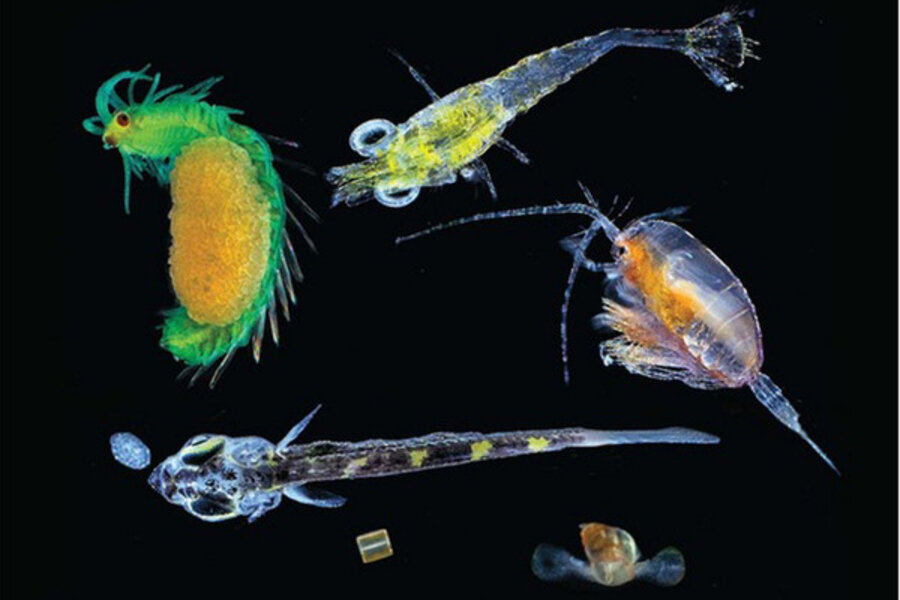Scientists gather 'tremendous' new data on tiny ocean creatures
Loading...
Call it the Microbe World Cruise, a 3-year project to take a census of the smallest denizens of the deep – from viruses and bacteria to tiny plankton.
The information gathered holds the potential to revolutionize humanity's understanding of the interactions among these marine no-see-ums and the critical roles they play in maintaining Earth as a livable planet, researchers say.
How big are those roles? For starters, "taking care of every other breath you take is pretty big," says Linda Amaral Zettler, a microbial ecologist at the Marine Biology Laboratory in Woods Hole, Mass., noting that plankton supply half of the atmosphere's oxygen.
Among the first-look results: Water temperature is the main factor in determining the richness of species and in the mix of functions they perform. The highest levels of diversity, for instance, currently appear at mid latitudes. Diversity shrinks toward the poles and the equator.
As ocean temperatures rise with global warming, the changes could dramatically alter the distribution and makeup of marine microbial communities and the food chains they support, the researchers say.
Initial analyses of the census, which was conducted between 2009 and 2012 aboard the 110-foot-long research schooner Tara, appear in five research papers summarized in Friday's issue of the journal Science and published in full on line.
The analyses represent a first cut at an enormous amount of data. The international research team taking part in the Tara Oceans project captured data ranging from viruses less than a millionth of a meter in size to plankton about 2 millimeters across. They gathered 35,000 samples from 210 locations around the world. The main focus was on organisms that live in the sunlit, upper 660 feet of the ocean. So far, the team has analyzed 579 samples from 75 of the 210 sampling sites.
"We have a lot of work to do to understand where these organisms fit into our understanding of life on the planet in general," says Chris Bowler, research director at France's National Center for Scientific Research and a member of the research team.
Even before that effort hits full stride, however, it's clear that the information the team has gathered will serve as a "tremendous resource" in efforts to understand the connections between the oceans and climate, understand how these organisms interact to support the marine food chain, and to understand the evolution of life on the planet, he noted during a briefing on the papers earlier this week.
Indeed, the results also could lead to new ways of looking at aspects of evolution itself, suggests Eric Karsenti, a researcher at the European Molecular Biology Laboratory in Heidelberg, Germany, and another member of the research team.
"The problem with the classical theory of evolution is that it fails altogether at explaining the generation of complexity," he writes in an email. "[Natural] selection filters out. It does not create anything."
The initial results point to enormous complexity in the ecosystems the samples represent. Large varieties of organisms rely on each other in such a tight-knit fashion that they could be continuously influencing each others' evolution.
Such co-evolution has long been noted in pairs of highly interdependent but biologically disparate organisms such as bees and flowers. The initial results hint that co-evolution may not be limited mainly to pairs of species but may drive development within large groups of diverse but interacting species.
"At this point it's merely an intuition, provoked by the data," Dr. Karsenti cautions. "But I find it interesting."
The release of these first sets of results appears at a time when marine biologists have seen a dramatic increase in the amount of information available on marine life.
In 2010, researchers concluded a 10-year Census of Marine Life, which uncovered more than 6,000 species new to science and involved some 2,700 scientists worldwide. Shortly after the census began, researchers recognized the need to include microbes, which account for 98 percent of the ocean's biomass. Microbes were the only life on Earth for the first 2 billion to 3 billion years after the first life emerged on the planet. The International Census of Marine Microbes was born.
Since then, "it's been an amazing decade of discovery for marine microbiology," says Dr. Zettler, who serves as the program manager for the marine-microbe census, but was not part of the Tara Oceans project.
Taken as a whole, census efforts over the past 15 years have lifted the lid from off "this huge treasure trove of information."
Still, researchers have sampled only a vanishingly small proportion of the oceans' volume, she says.
The data also yielded insights into the oceans' mass-transit system for plankton, which travel at the mercy of currents. The researchers describe how vast rotating eddies known as Agulhas rings transport large populations of plankton that originated in the Indian Ocean into the Atlantic.
These rings, which spin off from southeastern Africa's Agulhas Current, not only transport populations horizontally, but they also draw up water from below. Some of the ring's planktonic passengers thrive on the composition of this deep water more than others, so the ring alters the population as it carries the plankton along. It's also leaky, researchers say, releasing some of the passengers along its path.
The study has generated a catalog of more than 40 million genes from the organisms they've sampled. About 80 percent of those appear to be genes scientists have never seen before. In addition, the researchers have found more than 5,000 populations of viruses throughout the world's upper oceans. Prior to the Tara Oceans expedition, researchers had uncovered only 39 populations.
The information is all the more valuable because the samples by nature included seawater, which yields its own trove of information about the environments the organisms inhabit. The team has made the Tara Oceans data freely available to researchers.
The vast collection of new data means that "life in the ocean is a little less murky than before," says Dr. Bowler.






